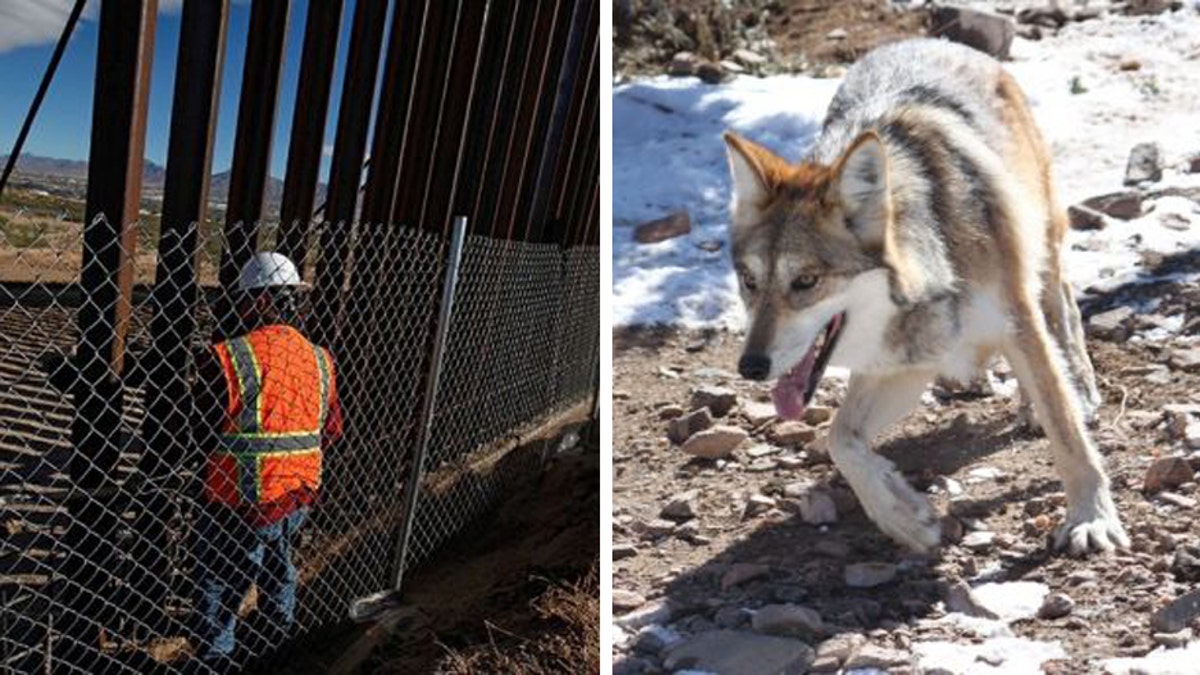
File photos - File photo - A U.S. worker builds a section of the U.S.-Mexico border wall at Sunland Park, U.S. opposite the Mexican border city of Ciudad Juarez, Mexico, November 9, 2016. Picture taken from the Mexico side of the U.S.-Mexico border/A Mexican gray wolf (REUTERS/Jose Luis Gonzalez/AP2011)
Over 2,500 scientists are warning that the border wall between the U.S. and Mexico will have a negative impact on wildlife.
The border wall was a key part of President Donald Trump’s election campaign, but continues to spark controversy. While Trump has reiterated his desire to strengthen America’s southern border, critics have questioned its effectiveness, its economic impact and its cost.
The President’s budget plan earlier this year included a $23 billion request for border security, $18 billion of which would be allocated to building a wall.
Published in the journal BioScience, the letter has been endorsed by over 2,500 scientists across the globe. The signatories warn that the wall spells bad news for the area’s nature.
HOW AI AND TECH COULD STRENGTHEN AMERICA'S BORDER WALL
“In North America, along the 3.200-kilometer [1,988-mile] US–Mexico border, fence and wall construction over the past decade and efforts by the Trump administration to complete a continuous border ‘wall’ threaten some of the continent's most biologically diverse regions,” the letter says. “Already-built sections of the wall are reducing the area, quality, and connectivity of plant and animal habitats and are compromising more than a century of binational investment in conservation.”
The border bisects areas inhabited by 1,506 native animal and plant species. Some 62 of these species are listed as Critically Endangered, Endangered, or Vulnerable by the International Union for Conservation of Nature (IUCN) Red List, according to the scientists.
By significantly altering the landscape, the border wall threatens a number of animal populations, the letter says. “Physical barriers prevent or discourage animals from accessing food, water, mates, and other critical resources by disrupting annual or seasonal migration and dispersal routes,” the scientists explain. Continuous walls, they add, could prevent endangered Peninsular bighorn sheep from moving between California and Mexico to access water and birthing sites.
It could also be difficult for other endangered animals such as the Mexican gray wolf and the Sonoran pronghorn to cross the border and re-establish recently destroyed populations or bolster small groups.
SOMEONE JUST KILLED ONE OF THE LAST REMAINING JAGUARS IN THE US
“As climate change and increasingly warm, dry conditions redistribute resources and shift habitats in the borderlands, the wall may prevent some populations from tracking these changes,” the letter reads. “Fragmented populations may suffer from reduced genetic diversity and face greater extinction risks.”
In the letter, scientists claim that the border wall bypasses environmental laws such as the Endangered Species Act (ESA) and the National Environmental Policy Act (NEPA). The border wall also devalues conservation investment and scientific research, they say.
Fox News has reached out to the White House and the Department of Homeland Security with a request for comment on this story.
Follow James Rogers on Twitter @jamesjrogers
